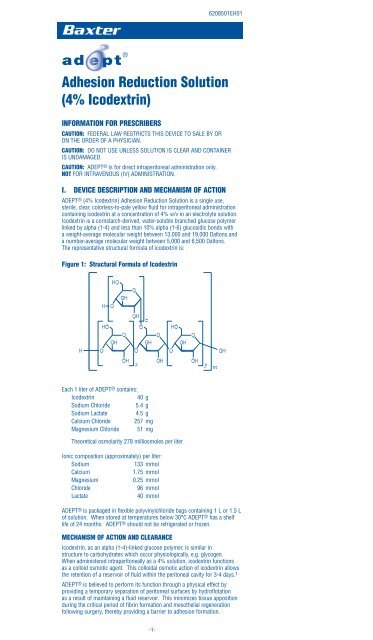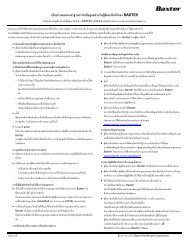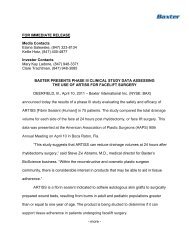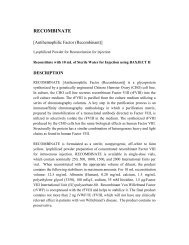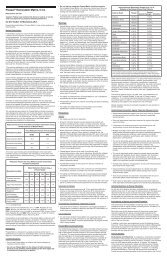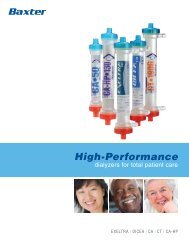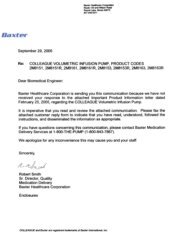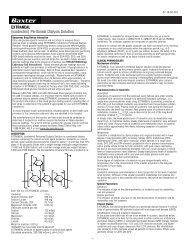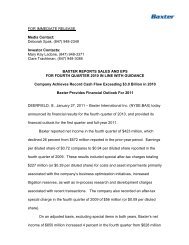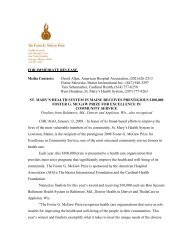4% Icodextrin - Baxter
4% Icodextrin - Baxter
4% Icodextrin - Baxter
You also want an ePaper? Increase the reach of your titles
YUMPU automatically turns print PDFs into web optimized ePapers that Google loves.
Adhesion Reduction Solution<br />
(<strong>4%</strong> <strong>Icodextrin</strong>)<br />
INFORMATION FOR PRESCRIBERS<br />
CAUTION: FEDERAL LAW RESTRICTS THIS DEVICE TO SALE BY OR<br />
ON THE ORDER OF A PHYSICIAN.<br />
CAUTION: DO NOT USE UNLESS SOLUTION IS CLEAR AND CONTAINER<br />
IS UNDAMAGED.<br />
CAUTION: ADEPT ® is for direct intraperitoneal administration only.<br />
NOT FOR INTRAVENOUS (IV) ADMINISTRATION.<br />
I. DEVICE DESCRIPTION AND MECHANISM OF ACTION<br />
ADEPT ® (<strong>4%</strong> <strong>Icodextrin</strong>) Adhesion Reduction Solution is a single use,<br />
sterile, clear, colorless-to-pale yellow fluid for intraperitoneal administration<br />
containing icodextrin at a concentration of <strong>4%</strong> w/v in an electrolyte solution.<br />
<strong>Icodextrin</strong> is a cornstarch-derived, water-soluble branched glucose polymer<br />
linked by alpha (1-4) and less than 10% alpha (1-6) glucosidic bonds with<br />
a weight-average molecular weight between 13,000 and 19,000 Daltons and<br />
a number-average molecular weight between 5,000 and 6,500 Daltons.<br />
The representative structural formula of icodextrin is:<br />
Figure 1: Structural Formula of <strong>Icodextrin</strong><br />
Each 1 liter of ADEPT ® contains:<br />
<strong>Icodextrin</strong> 40 g<br />
Sodium Chloride 5.4 g<br />
Sodium Lactate 4.5 g<br />
Calcium Chloride 257 mg<br />
Magnesium Chloride 51 mg<br />
Theoretical osmolarity 278 milliosmoles per liter<br />
Ionic composition (approximately) per liter:<br />
Sodium 133 mmol<br />
Calcium 1.75 mmol<br />
Magnesium 0.25 mmol<br />
Chloride 96 mmol<br />
Lactate 40 mmol<br />
ADEPT® is packaged in flexible polyvinylchloride bags containing 1 L or 1.5 L<br />
of solution. When stored at temperatures below 30°C ADEPT® has a shelf<br />
life of 24 months. ADEPT® should not be refrigerated or frozen.<br />
MECHANISM OF ACTION AND CLEARANCE<br />
<strong>Icodextrin</strong>, as an alpha (1-4)-linked glucose polymer, is similar in<br />
structure to carbohydrates which occur physiologically, e.g. glycogen.<br />
When administered intraperitoneally as a <strong>4%</strong> solution, icodextrin functions<br />
as a colloid osmotic agent. This colloidal osmotic action of icodextrin allows<br />
the retention of a reservoir of fluid within the peritoneal cavity for 3-4 days.1<br />
ADEPT ® is believed to perform its function through a physical effect by<br />
providing a temporary separation of peritoneal surfaces by hydroflotation<br />
as a result of maintaining a fluid reservoir. This minimizes tissue apposition<br />
during the critical period of fibrin formation and mesothelial regeneration<br />
following surgery, thereby providing a barrier to adhesion formation.<br />
-1-<br />
6208501EH01
Pharmacokinetics of <strong>Icodextrin</strong><br />
Absorption<br />
Absorption of icodextrin from the peritoneal cavity follows zero-order kinetics,<br />
consistent with convective transport via the lymphatic pathways. Studies in<br />
patients undergoing continuous ambulatory peritoneal dialysis (CAPD)<br />
indicate that a median of 40% of the instilled icodextrin was absorbed from<br />
the peritoneal solution during a 12 hour dwell.2<br />
Metabolism and Elimination<br />
When given intraperitoneally, the icodextrin polymer is not metabolized<br />
significantly in the peritoneal cavity but is slowly transferred into the systemic<br />
circulation by peritoneal lymphatic drainage. In the systemic circulation<br />
icodextrin is rapidly metabolized by alpha-amylase to lower molecular weight<br />
oligosaccharides, which along with icodextrin, are eliminated by renal<br />
excretion. The rate of clearance of icodextrin from the systemic circulation<br />
has been estimated to be equal to glomerular filtration rate.<br />
II. INDICATION, CONTRAINDICATIONS, WARNINGS AND<br />
PRECAUTIONS<br />
INDICATION FOR USE<br />
ADEPT ® Adhesion Reduction Solution is indicated for use intraperitoneally as<br />
an adjunct to good surgical technique for the reduction of post-surgical<br />
adhesions in patients undergoing gynecological laparoscopic adhesiolysis.<br />
CONTRAINDICATIONS<br />
ADEPT ® is contraindicated:<br />
• In patients with known or suspected allergy to cornstarch based<br />
polymers e.g. icodextrin, or with maltose or isomaltose intolerance,<br />
or with glycogen storage disease.<br />
• In the presence of frank infection (e.g. peritonitis) in the abdominopelvic<br />
cavity.<br />
• In procedures with laparotomy incision. Serious post-operative wound<br />
complications including dehiscence and cutaneous fistula formation<br />
have been reported from clinical experience outside the US when<br />
ADEPT® was used in surgical cases with laparotomy incision.<br />
• In procedures involving bowel resection or repair, or appendectomy.<br />
Anastomotic failure, ileus and peritonitis following procedures<br />
involving bowel resection and instillation of ADEPT® have been<br />
reported from clinical experience outside of the US.<br />
WARNINGS<br />
• There have been rare reports of sterile peritonitis following the use of<br />
icodextrin. The differential diagnosis of abdomino-pelvic pain following<br />
instillation of ADEPT® should include peritoneal cavity infection,<br />
perforated bowel or other viscous, intraperitoneal bleeding, and other<br />
life threatening post-operative complications in addition to sterile<br />
peritonitis.<br />
• Leaking ADEPT® fluid through laparoscopic port sites post-operatively<br />
is associated with wound complications such as subcutaneous fluid<br />
collection, skin separation and infection. Meticulous closure of fascia<br />
may help reduce wound complications related to fluid extravasation<br />
following gynecologic laparoscopy surgery.<br />
• There have been rare reports of hypersensitivity reactions in patients<br />
treated with ADEPT®. Anaphylaxis has been reported in a few<br />
patients.<br />
• There are rare reports of pulmonary edema, pulmonary effusion and<br />
arrhythmia from clinical experience with ADEPT® outside of the US.<br />
These cases tended to occur in elderly or otherwise debilitated patients<br />
(e.g. cancer patients). The potential benefit of ADEPT® for adhesion<br />
prevention should be carefully weighed against the risk of serious<br />
complications in patients with serious co-morbidities.<br />
• Foreign body reactions may occur with ADEPT®, as with any<br />
implanted material.<br />
PRECAUTIONS<br />
• ADEPT ® is for direct intraperitoneal administration only.<br />
NOT for intravenous (IV) administration.<br />
• ADEPT ® is not indicated as a delivery system for intraperitoneal drugs<br />
such as antibiotics and chemotherapeutic agents.<br />
• The effectiveness of ADEPT ® has not been established for longer term<br />
clinical outcomes following gynecological surgery, e.g. pregnancy and<br />
pain.<br />
• Self-limited vulvar swelling is a known side-effect of instilling large<br />
volumes of fluid into the abdomino-pelvic cavity. Most cases resolve<br />
within one week of surgery. When swelling is associated with urinary<br />
retention, catheterization may be necessary.<br />
• Maltose metabolites of icodextrin may interfere with blood glucose<br />
measurement in diabetic patients who use rapid blood glucose<br />
systems that are not glucose specific.<br />
-2-
• The safety and effectiveness of ADEPT ® have not been evaluated:<br />
• in patients less than 18 years of age;<br />
• in pregnancy;<br />
• when volume left in peritoneal cavity exceeds 1 L;<br />
• in patients with abnormal liver and/or renal function; or<br />
• in cases where there is a breach in the vaginal epithelium;<br />
III. ADVERSE EVENTS<br />
Postmarketing Passive Surveillance Outside of US<br />
ADEPT ® Adhesion Reduction Solution was approved for use in Europe in<br />
October 1999. A Europe-wide multicenter registry for evaluating clinical<br />
experience using ADEPT® was launched in 2000. The ARIEL registry was<br />
intended to capture the experience of surgeons using ADEPT® in both general<br />
and gynecological surgery. Data were collected between September 2000 and<br />
December 2003.<br />
A total of 4620 patients were enrolled in the ARIEL registry. Of these,<br />
2882 were gynecology patients (72% laparoscopy) and 1738 were<br />
general surgery patients (85% laparotomy). Adverse events were reported<br />
in 7.5% gynecological laparoscopy and 13.9% gynecological laparotomy<br />
patients compared with 16.7% general surgery laparoscopy and 30.6%<br />
general surgery laparotomy patients.3, 4 Table 1 summarizes key events.<br />
These events are presented regardless of the reporting surgeon’s causality<br />
assessment.<br />
Table 1. Selected Key Adverse Events from ARIEL Registry a<br />
Adverse<br />
Event<br />
US Clinical Trial Experience<br />
Gynecology<br />
N=2882<br />
Laparoscopy Laparotomy Not<br />
known<br />
ADEPT ® has been studied in three randomized, controlled US clinical trials<br />
involving a total of 548 patients undergoing gynecological laparoscopic<br />
surgery with second look laparoscopy 4-12 weeks after the initial procedure.<br />
In all three studies, the control device was Lactated Ringer’s Solution (LRS).<br />
Two pilot studies to obtain preliminary safety data enrolled a total of 99<br />
(59 ADEPT® treated, 40 LRS) patients. The third US clinical trial of ADEPT ®<br />
was a double-blind pivotal study in which 449 subjects (227 ADEPT ® treated,<br />
222 LRS) were treated.<br />
Pilot Studies:<br />
In the first pilot study (CLASSIC), 62 subjects (34 ADEPT ® and 28 LRS)<br />
were evaluated. Approximately two liters of solution were used for irrigation<br />
intraoperatively, and one liter was instilled at the end of the procedure.<br />
Two cases of moderate labial or vulvar swelling were reported in the ADEPT®<br />
subjects. There were no LRS-related adverse events.<br />
In the second pilot study (RAPIDS), 37 subjects (25 ADEPT ® and 12 LRS)<br />
were evaluated. Approximately 1500-1900 mL of solution were used for<br />
irrigation intraoperatively. An average 2L of ADEPT® vs. 1300mL LRS was<br />
instilled at the end of the procedure. The objective of this study was to<br />
evaluate the safety of larger volumes of ADEPT® as a post-operative instillate.<br />
One case of labial swelling was reported in an ADEPT® subject.<br />
Pivotal Clinical Trial:<br />
In the double-blind, pivotal study, ADEPT ® or LRS was used as an intraoperative<br />
irrigant (100mL every 30 minutes) and 1L was instilled into the<br />
peritoneal cavity at the end of the procedure. 221 (97.<strong>4%</strong>) ADEPT® patients<br />
reported a total of 1065 events compared to 218 (98.2%) LRS patients who<br />
reported 1047 events.<br />
Table 2 presents adverse events reported in > 5% of patients (regardless of<br />
causality) in the pivotal trial.<br />
-3-<br />
General Surgery<br />
N=1738<br />
Laparoscopy Laparotomy Not<br />
known<br />
Wound<br />
Complication b 13 15 1 2 68 4<br />
Vulvar<br />
Swelling<br />
Failed<br />
anastamosis<br />
7 1 3 0 1 0<br />
0 0 0 4 33 0<br />
Ileus 3 2 1 4 46 1<br />
Pain 15 10 2 4 9 0<br />
Pulmonary<br />
Complication<br />
0 3 0 1 7 0<br />
Allergic<br />
Reactionc 0 2 0 0 2 0<br />
a Adverse events in this table were tabulated using a different methodology from that of<br />
Sutton3 et al., and Menzies4 et al. Therefore, numbers of events in different categories<br />
may not correspond exactly with the numbers in the published literature.<br />
b “Wound complication” includes subcutaneous fluid collection near the incision/port site.<br />
c <strong>Icodextrin</strong> has been associated with skin reactions such as rash. Three of the cases in the<br />
above table were more serious events and had systemic involvement.
Table 2: Pivotal Study Most Frequent Adverse Events<br />
(i.e. those reported by at least 5% of patients in either group,<br />
regardless of causality) – Intention-to-Treat (ITT) Population<br />
ADEPT ® LRS<br />
Number of Number of Number of Number of<br />
patients reporting reports patients reporting reports<br />
Total number of<br />
patients at risk<br />
227 222<br />
Post procedural pain 192 (84.6%) 223 194 (87.<strong>4%</strong>) 233<br />
Headache 81 (35.7%) 131 72 (32.<strong>4%</strong>) 127<br />
Nausea<br />
Leaking from Port<br />
39 (17.2%) 41 37 (16.7%) 41<br />
Sites Post-procedure 31 (13.7%) 31 30 (13.5%) 30<br />
Dysmenorrhea 30 (13.2%) 32 26 (11.7%) 34<br />
Constipation 24 (10.6%) 26 23 (10.<strong>4%</strong>) 24<br />
Pelvic pain 23 (10.1%) 32 21 (9.5%) 21<br />
Arthralgia 20 (8.8%) 22 19 (8.6%) 19<br />
Flatulence 19 (8.<strong>4%</strong>) 19 17 (7.7%) 19<br />
Urinary tract infection 16 (7.0%) 17 12 (5.<strong>4%</strong>) 13<br />
Abdominal pain 15 (6.6%) 26 19 (8.6%) 23<br />
Dysuria 15 (6.6%) 16 8 (3.6%) 9<br />
Nasopharyngitis 15 (6.6%) 15 18 (8.1%) 18<br />
Vaginal bleeding 14 (6.2%) 15 5 (2.3%) 5<br />
Abdominal distension 13 (5.7%) 13 10 (4.5%) 10<br />
Post procedural nausea 13 (5.7%) 13 20 (9.0%) 20<br />
Pyrexia 13 (5.7%) 13 7 (3.2%) 7<br />
Vomiting<br />
Labial, Vulvar or<br />
13 (5.7%) 13 22 (9.9%) 22<br />
Vaginal swelling 13 (5.7%) 13 1 (0.45%) 1<br />
Back pain 12 (5.3%) 15 12 (5.<strong>4%</strong>) 13<br />
Insomnia 12 (5.3%) 14 8 (3.6%) 8<br />
Cough 10 (4.<strong>4%</strong>) 10 12 (5.<strong>4%</strong>) 13<br />
Diarrhea 3 (1.3%) 3 13 (5.9%) 15<br />
In the pivotal study, the most frequently occurring (report incidence as % of number of patients)<br />
treatment-related adverse events between surgeries were post procedural leaking from port sites,<br />
labial, vulvar or vaginal swelling and abdominal distension.<br />
IV. CLINICAL STUDIES<br />
ADEPT ® has been studied in the USA in two pilot studies and one doubleblind,<br />
pivotal study in female patients undergoing gynecological laparoscopic<br />
surgery with a planned second look laparoscopy. The studies were<br />
conducted to evaluate the safety and effectiveness of the device as an adjunct<br />
to good surgical technique in the reduction of post-surgical adhesions in<br />
comparison to (LRS). ADEPT® or LRS was used as an intra-operative<br />
irrigant (100 mL every 30 minutes) in all studies; in the pivotal study, 1L of<br />
ADEPT® or LRS was instilled into the peritoneal cavity at the end of the<br />
surgical procedure. In the pilot studies, 1L in the first study and up to 2L in<br />
the second study were instilled at the end of surgery. In all three studies, the<br />
incidence, extent and severity of adhesions were assessed at 23 prospectively<br />
determined anatomical sites, using established adhesion scoring methods<br />
at baseline surgery (prior to adhesiolysis) and at second look laparoscopy.<br />
Safety was evaluated based on adverse events and clinical laboratory tests.<br />
For both pilot studies, second look laparoscopy took place 6-12 weeks after<br />
the initial surgery. In both of these studies, there was a greater reduction in<br />
the number of sites with adhesions, and the extent and severity of adhesions<br />
in the ADEPT® subjects compared to the LRS subjects. However, these<br />
differences were not statistically significant, which may be due in part to the<br />
relatively small numbers of subjects in these studies.<br />
PIVOTAL STUDY<br />
The pivotal study was a comparative, double-blind, randomized, multicenter<br />
study in the USA. A total of 449 female patients aged eighteen or over were<br />
enrolled for whom laparoscopic peritoneal cavity surgery was planned for a<br />
gynecological procedure which included adhesiolysis and who agreed to<br />
undergo second look laparoscopy as part of their treatment plan at 4-8 weeks<br />
after the initial surgery. The patients had to have adhesions at three or more<br />
of the 23 pre-specified anatomical sites and adhesions at three or more of the<br />
anatomical sites had to be lysed during the surgery.<br />
Objectives<br />
The study objectives were to determine the effectiveness and safety of<br />
ADEPT® when used as an intraoperative washing solution with a<br />
postoperative instillate in the reduction of post-surgical adhesions after<br />
laparoscopic surgery for adhesiolysis, compared with LRS.<br />
Inclusion Criteria:<br />
• willing, able to and having freely given written consent to participate<br />
in the study and abide by its requirements;<br />
• female patients aged eighteen and over, in good general health<br />
including ASA (American Society of Anesthesiologists ) score of<br />
2 or less;<br />
-4-
• laparoscopic peritoneal cavity surgery is planned for a gynecologic<br />
procedure which includes adhesiolysis; and<br />
• patient agrees to planned second look laparoscopy for this study 4-8<br />
weeks after the initial surgical procedure.<br />
Exclusion Criteria (pre-operative):<br />
• current pregnancy including ectopic pregnancy;<br />
• SGOT, SGPT and/or bilirubin > 20% above the upper range of normal<br />
and considered clinically significant;<br />
• BUN and creatinine > 30% above the upper range of normal and<br />
considered clinically significant;<br />
• concurrent use of systemic corticosteroids, antineoplastic agents<br />
and/or radiation;<br />
• active pelvic or abdominal infection;<br />
• known allergy to starch-based polymers; and<br />
• additional surgical procedure (non-OB/GYN) planned to be performed<br />
during the laparoscopic procedure.<br />
Exclusion Criteria (intra-operative):<br />
• clinical evidence of cancer;<br />
• clinical evidence of pregnancy including ectopic pregnancy;<br />
• use during this procedure of any approved or unapproved product<br />
for the purpose of preventing adhesion formation;<br />
• fewer than 3 of the available anatomical study sites contain adhesions;<br />
• less than three of the anatomical sites are lysed;<br />
• if the procedure needs to be performed by a laparotomy (decision<br />
made after laparoscopy has commenced);<br />
• if any of the anatomical sites being scored for the purposes of this<br />
study are being removed during surgery;<br />
• if all of the available anatomical sites cannot be visualized and<br />
recorded on the video tape during the surgery; and<br />
• any unplanned surgery which involves opening of the bowel<br />
(excluding appendectomy).<br />
Study Hypotheses<br />
There were three co-primary outcome measures, each with a respective<br />
hypothesis:<br />
(1) The first co-primary endpoint for the pivotal study was the<br />
difference (for an individual study subject) in the number of<br />
adhesion sites between baseline and second look laparoscopy.<br />
For subjects with ten or fewer adhesions lysed at surgery, an<br />
individual patient success was defined as a decrease of at least<br />
3 sites with adhesions between baseline and second look<br />
laparoscopy. For subjects with more than ten adhesions lysed<br />
at baseline, individual patient success was defined as a decrease<br />
in adhesion sites of at least 30% between baseline and second<br />
look laparoscopy. The study hypothesis for the first co-primary<br />
endpoint was that the lower bound of the 95.2% CI around the<br />
difference in success rates will be above 5%.<br />
(2) The second co-primary endpoint was the difference (for an<br />
individual study subject) in the number of adhesion sites between<br />
baseline and second look laparoscopy. In the hypothesis for<br />
this endpoint, patients served as their own control. The study<br />
hypothesis for the 2nd co-primary endpoint was that ADEPT®<br />
treated subjects would have fewer sites with adhesions at second<br />
look laparoscopy than they had at baseline.<br />
(3) The third co-primary endpoint was the difference (for an individual<br />
subject) in the number of dense adhesion sites between baseline<br />
and second look laparoscopy. For the 3rd co-primary endpoint,<br />
success for a subject was defined as any reduction in dense<br />
adhesion sites between baseline and second look laparoscopy.<br />
The study hypothesis for the 3rd co-primary endpoint was that<br />
the success rate for ADEPT®-treated subjects would be greater<br />
than that for LRS treated subjects.<br />
Secondary Endpoints<br />
The study had the following pre-specified secondary endpoints.<br />
No hypothesis tests were specified for these endpoints.<br />
Incidence of sites with adhesions<br />
Severity of sites with adhesions<br />
Extent of sites with adhesions<br />
American Fertility Society (AFS) score<br />
Modified AFS score<br />
Reformed adhesions<br />
De novo adhesions<br />
Abdominal wall adhesions<br />
Visceral adhesions<br />
Visual Analog Scale (VAS) score for pelvic pain<br />
-5-
Figure 2 is a patient accounting of all subjects in the pivotal study, including<br />
the initial screen.<br />
Figure 2: Patient Accounting<br />
Withdrawn<br />
N = 15<br />
Excluded from PP<br />
N = 9<br />
Randomized to ADEPT ®<br />
ITT Population<br />
N = 227<br />
Completed Study<br />
N = 212<br />
ADEPT ® PP Population<br />
N = 203<br />
Patients Screened<br />
N = 777<br />
Patients Randomized<br />
N = 449<br />
-6-<br />
Randomized to LRS<br />
ITT Population<br />
N = 222<br />
Completed Study<br />
N = 208<br />
LRS PP Population<br />
N = 199<br />
Screening Failures<br />
N = 328<br />
Withdrawn<br />
N = 14<br />
Excluded from PP<br />
N = 9<br />
Table 3: Pivotal Study Demographics and Baseline Data, ITT<br />
ADEPT ® LRS<br />
No. of patients randomized (ITT)<br />
Demographics ± s.d.<br />
227 222<br />
Age, yr 32.6 ± 5.9 32.3 ± 5.7<br />
Height, in (n) 64.7 ± 2.7 (225) 64.2 ± 2.8 (221)<br />
Weight, lb (n) 153.2 ± 36.9 (225) 152.0 ± 35.0 (220)<br />
Race Caucasian 160 (70.5%) 144 (64.9%)<br />
n (%): East Asian 3 (1.3%) 7 (3.2%)<br />
African American 32 (14.1%) 32 (14.<strong>4%</strong>)<br />
Hispanic 24 (10.6%) 35 (15.8%)<br />
Oriental 3 (1.3%) 1 (0.5%)<br />
Base vital signs<br />
Other 5 (2.2%) 3 (1.<strong>4%</strong>)<br />
Systolic blood pressure, mmHg (n) 114.9 ± 12.1 (224) 114.5 ± 11.8 (221)<br />
Diastolic blood pressure, mmHg (n) 71.5 ± 8.8 (224) 71.4 ± 8.8 (221)<br />
Heart rate, bpm (n)<br />
Primary diagnosis n (%)<br />
73.1 ± 8.8 (224) 73.2 ± 8.3 (218)<br />
Pelvic pain 152 (67.0%) 134 (60.<strong>4%</strong>)<br />
Endometriosis 94 (41.<strong>4%</strong>) 93 (41.9%)<br />
Infertility 115 (50.7%) 127 (57.2%)<br />
Adhesions 126 (55.5%) 127 (57.2%)<br />
Others<br />
Medical history n (%)<br />
36 (15.9%) 43 (19.<strong>4%</strong>)<br />
No. of patients with resolved medical conditions 192 (84.6%) 191 (86.0%)<br />
No. of patients with ongoing medical conditions 224 (98.7%) 219 (98.6%)<br />
No. of patients with surgical history<br />
Baseline assessment of adhesions<br />
205 (90.3%) 196 (88.3%)<br />
Number of Sites with Adhesions 10.27 ± 4.26 10.34 ± 4.39<br />
Number of Sites with lysed Adhesions 8.69 ± 4.15 8.46 ± 4.02<br />
Number of Sites with dense Adhesions 6.17 ± 4.74 6.23 ± 5.26<br />
Number of Sites with lysed dense Adhesions 5.35 ± 4.56 5.15 ± 4.46<br />
Baseline AFS score for infertility subgroup (PP) 9.52 ± 10.39 8.60 ± 9.99<br />
Baseline mAFS score (PP)<br />
Endometriosis n (%)<br />
2.71 ± 2.47 2.81 ± 2.93<br />
Present at baseline 140 (61.7%) 135 (60.8%)<br />
Treated<br />
Others<br />
138 (60.8%) 135 (60.8%)<br />
Operative Time (mins) (median) (ITT) 85.0 88.0<br />
Days between first and second look surgery (ITT) 39.9 ± 10.3 39.9 ± 10.7<br />
Average volume of solution lavaged and 3,502 3,570<br />
instilled, ml (min-max) (1,300-12,000) (1,300-12,000)<br />
Table 3 shows that the study arms were well balanced. Almost all sites with adhesions were<br />
lysed (on average 10 at baseline with 9 lysed for both groups). Similarly, almost all sites with<br />
dense adhesions were lysed (on average 6 at baseline and 5 lysed). The study population had a<br />
fairly substantial adhesion burden with an average of 10 sites per subject and 6 sites with dense<br />
adhesions per subject.
Pivotal Study Results<br />
Primary Effectiveness Endpoints<br />
First Co-Primary Endpoint: 45.<strong>4%</strong> of the patients in the ADEPT ® group<br />
were defined as a “clinical success” compared to 35.6% in the LRS group<br />
(p=0.016, two-tailed test) (Table 4). However, the lower bound of the<br />
95.2% CI around the difference in success rates (0.7%) is below the<br />
pre-specified 5% target. Data is presented as intent-to-treat (ITT).<br />
(see Figure 3.)<br />
Figure 3: Pivotal Study First primary effectiveness endpoint<br />
(percentage of patients achieving “success”) –<br />
Intention to Treat population<br />
50<br />
45<br />
40<br />
35<br />
45.4<br />
30<br />
25<br />
20<br />
15<br />
10<br />
5<br />
0<br />
35.6<br />
LRS<br />
% patients with “success”<br />
Second Co-Primary Endpoint: Patients in the ADEPT® group had<br />
significantly fewer sites with adhesions at second look compared to first<br />
look laparoscopy (p
Table 4: Pivotal Study Primary Effectiveness Endpoints –<br />
Intention-to-Treat population<br />
First primary effectiveness endpoint<br />
ADEPT ® LRS<br />
Total number of patients<br />
Success<br />
227 222<br />
a<br />
Number reporting 103 (45.<strong>4%</strong>) 79 (35.6%)<br />
Difference in % of patients with success 9.8<br />
Se 4.6<br />
95.2 CI for % of patients with success (0.7, 18.9)<br />
Odds ratiob 1.64<br />
95.2% CI for odds ratio (1.09, 2.46)<br />
p-value for treatment 0.016*<br />
a Success was achieved if the number of sites with adhesions decreased by at least the larger<br />
of three sites or 30% of the number of sites lysed<br />
b Estimated from a logistic regression model with factors for treatment group and center.<br />
A value >1 favors ADEPT ® . The odds ratio (95.2% CI) using exact methods was<br />
1.61 (1.06, 2.46).<br />
* Statistically significant at the 4.8% level, two-tailed<br />
Second primary effectiveness endpoint<br />
ADEPT ® LRS<br />
Total number of patients<br />
Number of sites with adhesions<br />
227 222<br />
First look (mean±sd) 10.27±4.26 10.34±4.39<br />
Second look (mean±sd) 7.88±4.64 8.49±4.98<br />
Change from first to second look (mean±sd) -2.40±3.66 -1.86±3.35<br />
LS mean for changea (95.2% CI) -2.22 (-2.83, -1.62) -1.60 (-2.24, -0.96)<br />
p-value for change
Table 5 : Pivotal Study Secondary Effectiveness Endpoints (PP)<br />
for Adhesions at Anatomical Sites<br />
Endpoint / Variable ADEPT ® LRS p-value*<br />
Incidence of sites with adhesions<br />
Change from 1st to 2nd look<br />
(n=203) (n=199)<br />
(mean ± s.d.) -2.64 ± 3.66 -2.02 ± 3.19 0.039<br />
% patients with reduction<br />
Change from 1st to 2nd look excluding<br />
76.<strong>4%</strong> 69.3% 0.121<br />
non-lysed sites (mean ± s.d.) -2.64 ± 3.66 -2.02 ± 3.19 0.068<br />
% patients with four or fewer sites<br />
with adhesions at 2nd look<br />
32.0 28.1 0.510<br />
Shift analysis - % patients with 2nd look 0: 4.9 0: 4.5<br />
incidence grouped into 4 categories 1-4<br />
5-9<br />
27.1<br />
36.0<br />
1-4<br />
5-9<br />
23.6<br />
31.7<br />
0.173<br />
Severity of sites with adhesions<br />
% change from 1st to 2nd look per patient<br />
>10 32.0 >10 40.2<br />
(mean ± s.d.) -24.2 ± 45.2 -21.5 ± 41.0 0.415<br />
% patients with reduction<br />
Extent of sites with adhesions<br />
% change from 1st to 2nd look per patient<br />
72.9% 69.8% 0.446<br />
(mean ± s.d.) -26.9 ± 51.4 -21.8 ± 48.5 0.240<br />
% patients with reduction<br />
Modified AFS score<br />
77.3% 69.8% 0.084<br />
Change from 1st to 2nd look (mean ± s.d.) -0.67 ± 1.54 -0.48 ± 1.61 0.094<br />
% patients with reduction<br />
* not adjusted for multiplicity.<br />
70.<strong>4%</strong> 69.8% 0.722<br />
Table 6: Pivotal Study Secondary Effectiveness Endpoints (PP)<br />
for Subgroup of Patients with a Primary Diagnosis of Infertility<br />
Endpoint / Variable ADEPT ® LRS p-value*<br />
(n=102) (n=112)<br />
AFS score<br />
Change from 1st to 2nd look for patients<br />
with a primary diagnosis of infertility<br />
(mean ± s.d.)<br />
% patients with reduction for patients<br />
-3.46 ± 6.77 -1.10 ± 6.36 0.011<br />
with a primary diagnosis of infertility 52.9% 30.<strong>4%</strong> 0.001<br />
Shift analysis - % patients with 2nd look minimal: 68.6 minimal: 59.8<br />
scores grouped into 4 categories for<br />
patients with a primary diagnosis<br />
mild: 10.8<br />
moderate: 11.8<br />
mild: 13.4<br />
moderate: 15.2<br />
0.041<br />
of infertility<br />
* not adjusted for multiplicity.<br />
severe: 8.8 severe: 11.6<br />
Table 7: Pivotal Study Secondary Effectiveness Endpoints (PP)<br />
for Types of and Location of Adhesions<br />
Endpoint / Variable ADEPT ® LRS p-value*<br />
Reformed adhesions<br />
Number of sites with reformed adhesions<br />
(n=203) (n=199)<br />
(mean ± s.d.)<br />
Number of sites without reformed adhesions<br />
4.92 ± 3.91 5.11 ± 4.12 0.722<br />
(mean ± s.d.) 3.77 ± 2.72 3.32 ± 2.29 0.065<br />
% patients with at least one<br />
De novo adhesions<br />
Number of sites with at least one de novo<br />
87.7% 86.9% 0.832<br />
adhesion (mean ± s.d.) 1.13 ± 1.85 1.29 ± 1.61 0.036<br />
% patients free of de novo adhesions<br />
Abdominal wall adhesions<br />
Change from 1st to 2nd look in number of sites<br />
52.7% 42.7% 0.029<br />
(mean ± s.d.)<br />
% patients with reduction from 1st to 2nd look<br />
-1.17 ± 1.63 -0.94 ± 1.60 0.184<br />
in no. sites<br />
Visceral adhesions<br />
Change from 1st to 2nd look in number of sites<br />
65.5% 58.3% 0.129<br />
(mean ± s.d.)<br />
% patients with reduction from 1st to 2nd look<br />
-1.47 ± 2.62 -1.07 ± 2.22 0.046<br />
in no. sites<br />
* not adjusted for multiplicity.<br />
68.5% 63.3% 0.228<br />
Table 8: Pivotal Study Secondary Effectiveness Endpoints (PP)<br />
for Subgroup of Patients with a Primary Diagnosis of Pelvic Pain<br />
Endpoint / Variable ADEPT ® LRS p-value*<br />
VAS score for pelvic pain<br />
Change from screening to 2nd look for patients<br />
with a primary diagnosis of pelvic pain<br />
(n=118) (n=108)<br />
(mean ± s.d.)<br />
* not adjusted for multiplicity.<br />
-35.8 ± 32.8 -30.8 ± 30.2 0.995<br />
-9-
V. DIRECTIONS FOR USE<br />
ADEPT ® is administered directly into the peritoneal cavity during laparoscopic<br />
gynecological surgery, being used as an irrigant solution during the course of<br />
surgery. Once the surgeon has completed the surgical procedure(s), the<br />
cavity is aspirated of all remaining fluid. A final volume of 1 liter of ADEPT®<br />
is then introduced into the cavity before removal of the scope.<br />
Using standard operating room technique:<br />
1. ADEPT ® should be warmed to approximately body temperature prior<br />
to use, using a device specifically intended for warming solutions in<br />
operating rooms.<br />
2. Remove the outer wrap from the ADEPT® bag and hang the sterile bag<br />
of solution on an I.V. pole.<br />
3. Remove the twist-off tab from the spike port and insert a giving set for<br />
connection to a laparoscope.<br />
4. ADEPT ® should be used intra-operatively as an irrigant solution, and<br />
as a post-operative instillate. The solution will flow through a giving<br />
set and through laparoscopes.<br />
5. When used as an intra-operative irrigant solution, at least 100 mL of<br />
ADEPT® should be introduced to the cavity every 30 minutes.<br />
6. Remove remaining fluid before introducing the final instillation.<br />
7. For the final instillation of ADEPT ®, prior to removal of the<br />
laparoscope, one liter (a new bag of ADEPT® if 1 liter bags are being<br />
used) should be used. Direct the solution at the operative sites in the<br />
first instance, the remainder being distributed throughout the cavity.<br />
8. Dispose of the bag and any unused portion of the solution following<br />
normal operating room biological hazard procedures.<br />
SEE FIGURE 4<br />
FIGURE 4<br />
Laparoscope<br />
within trocar<br />
Giving set<br />
Twist off port<br />
-10-<br />
Roller clamp<br />
Luer-lock for direct<br />
connection to laparoscope<br />
IV pole
HOW SUPPLIED<br />
ADEPT ® is packaged in single use, flexible polyvinylchloride bags, fitted with<br />
connecting ports, containing 1 liter or 1.5 liters of solution. The product is<br />
presented sterile (by heating in an autoclave). The bags are packaged in<br />
cartons of 10 x 1 liter or 5 x 1.5 liters.<br />
STORAGE<br />
ADEPT ® should not be stored above 30°C. Do not refrigerate or freeze.<br />
ADEPT ® may be kept in a warming device for up to 14 days, provided it is<br />
not removed and then replaced back in the warming device. At all other<br />
times, storage below 4°C or above 30°C is not recommended.<br />
References:<br />
1 Hosie K, Gilbert JA, Kerr D, Brown CB, Peers EM. Fluid dynamics in man<br />
of an intraperitoneal drug delivery solution: <strong>4%</strong> icodextrin. Drug Deliv<br />
2001; 8: 9-12<br />
2 Moberly JB et al., Pharmacokinetics of <strong>Icodextrin</strong> in peritoneal dialysis<br />
patients. Kidney International 62, Suppl.81, 2002, S23-S33.<br />
3 Sutton C, Minelli L, Garcia E et al. Use of <strong>Icodextrin</strong> <strong>4%</strong> solution in the<br />
reduction of adhesion formation after gynaecological surgery.<br />
Gynecological Surgery 2005; 2(4): 287-296.<br />
4 Menzies D, Hidalgo M, Walz MD et al. Use of <strong>Icodextrin</strong> <strong>4%</strong> solution in<br />
the prevention of adhesion formation following general surgery. Annals<br />
of the College of Surgeons of England 2006; 88 (4): 375-382.<br />
ADEPT is a registered trademark of Innovata plc<br />
Manufactured for:<br />
<strong>Baxter</strong> Healthcare Corporation<br />
Deerfield, IL 60015 USA<br />
6208501EH01<br />
-11-


